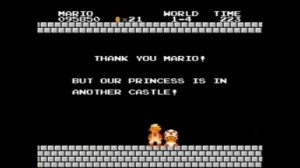
Still from Mario Brothers
Researchers aimed to outline some substantial and substantiated trends in serious games and their role in formal education, but ended up trapped in the old chicken-and-egg conundrum.
The meta-analysis by nine researchers aimed to assess how games are being used to improve classroom education, but they ran into a problem. As they themselves put it, “there is limited evidence to suggest how educational games can be used to solve the problems inherent in the structure of traditional K–12 schooling and academia. Indeed, if you are looking for data to support that argument, then we are sorry, but your princess is in another castle.”
There are some reasons for this, it appears. First, there have been few truly scientific tests of the effects of games in the classroom (call that the chicken) and second, without better information about what works, there are few games that fit into instructional plans (the egg) that effectively enforce and expand the learning goals.
The study also concluded that at times it is hard to decide how much the games are helping students learn because at times the difference between traditional classroom and game-play becomes blurred.
“Many educational games have assimilated game features into the constraints of the school day, becoming 20-minute activities with associated work sheets that lack a multiplayer continuity and the extended engagement characteristic of games played for purely entertainment value. Such adaptations may mask the potential learning benefits of video games,” the authors argue.
Still, the research has some good data and a few recommendations worth noting:
Key Findings
- 60% of Americans between the ages of 8-18 play a video game in an average day. This is up from 52% in 1999.
- “Ensure that game objectives and learning objectives correspond.”
Translation: Educational games work best when they have clear goals that match the goals of the teacher. - “We believe that commercial gaming companies and educational researchers could mutually benefit by bringing academic content into the fictitious worlds originally created without educational content objectives in mind.”
Translation: the authors argue that commercial games like World of Warcraft and others could serve as an experimental lab for educational gaming research, if they were up to it.
The authors end with a plea to get more sophisticated in studying gaming and learning. They point out that many games are played over years and so trying to assess the educational impact in a class or even academic semester may not be taking a long enough view. Additionally, the role of other players in games should not be overlooked in future research as, they argue, much of the education happens between players as well as between the game and the individual.
The reason to do all this is simple, they argue. By being smarter about how the learning is conveyed through games we all will create and design smarter games.
